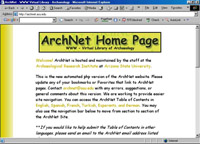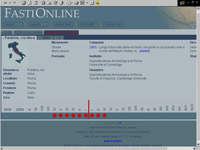
Figure 4a: ArchNet Portal
If we search on the web for the word 'archaeology' in several languages, using the most popular search engines, we get the following figures:
| Term | Language | Yahoo | MSN | |
|---|---|---|---|---|
| archaeology | English UK | 21,400,000 | 9,370,000 | 4,248,498 |
| archeology | English US | 1,550,000 | 1,860,000 | 690,183 |
| archéologi | French | 1,380,000 | 1,050,000 | 25,715 |
| archaeologie | German | 169,000 | ||
| arqueologia | Spanish | 270,000 | ||
| archeologia | Italian | 442,000 | ||
| archeologie | Dutch | 428,000 | 267,000 | 124,265 |
| archeologia | Polish | 119,000 | ||
| arheologie | Romanian | 35,800 | 28,000 | 25,715 |
These results are just a suggestion of proportions, not accurate statistics of language use in archaeology: my search ignored the other grammatical forms of the word and many languages. Also, repeated searches, using the main search engines at short time intervals, gave slightly different figures. Some conclusions are obvious however: English is dominant, but a surprisingly high number of web pages referring to archaeology are developed in other languages. In how many? Difficult to say, because we cannot yet search for 'archaeology' as a concept and get all the instances in various languages.
A growing number of websites are related to archaeology, probably hundreds of thousands. Over 100,000 pages are relevant to European archaeology (van Leusen 2001, 303). Like other scientific domains, archaeology benefits from the new communication technologies. The Internet started as an almost entirely English communication tool but things have changed over time, as more and more people from other language communities became Internet users. Cyberspace increasingly reflects the distribution of language presence in the real world and the trend will continue (Crystal 2001, 219).
Archaeological portals for an international public develop multilingual interfaces. An example is ArchNet, WWW - Virtual Library of Archaeology, maintained by the Archaeological Research Institute at Arizona State University, with interface versions in English, Spanish, French, Turkish, Esperanto and German (Figure 4a). Volunteers are invited to submit a table of contents in any other language. The Archaeological Resource Guide for Europe (ARGE) is the largest collection of evaluated links regarding European Archaeology (1700 links from 42 countries; Figure 4b). It interface is in English and Dutch, being maintained by Martijn van Leusen at the University of Groningen. This valuable portal is sporadically funded and therefore has no resources to develop multilingually or to keep the content and IT tools updated. It is a typical example of a European-scale service that should be supported by European organizations on a permanent base and it is not, while short-term projects mushroom then die shortly after funding ceases.
A new multilingual project is FASTI ONLINE, an international database of archaeological excavation reports from the area of the Roman Empire. The project has a map interface and search options by period, location and keywords (Figure 5). It is maintained by the International Association of Classical Studies and sponsored by the Packard Humanities Institute. At present in English and Italian, the FASTI team have signed co-operation agreements with organisations from other countries and the user interface will be developed in several languages. The Institute for Cultural Memory will provide the Romanian reports. A Romanian interface of the site is under construction. A Romanian-speaking user will certainly enjoy searching in Romanian, getting results with field names in Romanian as well as some of the reports.

Figure 5: FASTI ONLINE: Romanian interface under construction
© Internet Archaeology/Author(s)
University of York legal statements | Terms and Conditions
| File last updated: Mon Mar 12 2012